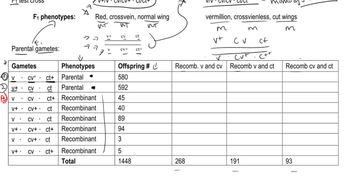Table of contents
- 1. Introduction to Genetics51m
- 2. Mendel's Laws of Inheritance3h 37m
- 3. Extensions to Mendelian Inheritance2h 41m
- 4. Genetic Mapping and Linkage2h 28m
- 5. Genetics of Bacteria and Viruses1h 21m
- 6. Chromosomal Variation1h 48m
- 7. DNA and Chromosome Structure56m
- 8. DNA Replication1h 10m
- 9. Mitosis and Meiosis1h 34m
- 10. Transcription1h 0m
- 11. Translation58m
- 12. Gene Regulation in Prokaryotes1h 19m
- 13. Gene Regulation in Eukaryotes44m
- 14. Genetic Control of Development44m
- 15. Genomes and Genomics1h 50m
- 16. Transposable Elements47m
- 17. Mutation, Repair, and Recombination1h 6m
- 18. Molecular Genetic Tools19m
- 19. Cancer Genetics29m
- 20. Quantitative Genetics1h 26m
- 21. Population Genetics50m
- 22. Evolutionary Genetics29m
4. Genetic Mapping and Linkage
Trihybrid Cross
Problem 23b
Textbook Question
Textbook QuestionA wild-type trihybrid soybean plant is crossed to a pure-breeding soybean plant with the recessive phenotypes pale leaf (l), oval seed (r), and short height (t). The results of the three-point test cross are shown below. Traits not listed are wild type.
Phenotype Number
Pale 648
Pale, oval 64
Pale, short 10
Pale, oval, short 102
Oval 6
Oval, short 618
Short 84
Wild type 98
1630
Calculate the recombination frequencies between the adjacent genes.
 Verified Solution
Verified SolutionThis video solution was recommended by our tutors as helpful for the problem above
Video duration:
2mPlay a video:
Was this helpful?
Key Concepts
Here are the essential concepts you must grasp in order to answer the question correctly.
Recombination Frequency
Recombination frequency is a measure of the likelihood that two genes will be separated during meiosis due to crossing over. It is calculated by dividing the number of recombinant offspring by the total number of offspring, then multiplying by 100 to express it as a percentage. This frequency helps in determining the genetic distance between genes on a chromosome.
Recommended video:
Guided course

Recombination after Single Strand Breaks
Trihybrid Cross
A trihybrid cross involves organisms that are heterozygous for three different traits. In this case, the wild-type soybean plant carries dominant alleles for traits such as leaf color, seed shape, and plant height, while the pure-breeding plant has recessive alleles. Analyzing the offspring from such a cross allows researchers to study the inheritance patterns and interactions of multiple genes.
Recommended video:
Guided course

Trihybrid Cross
Three-Point Test Cross
A three-point test cross is a genetic cross used to determine the arrangement of three linked genes on a chromosome. By crossing a trihybrid organism with a homozygous recessive organism, the resulting offspring's phenotypes can reveal the linkage and order of the genes. The phenotypic ratios observed in the offspring help calculate recombination frequencies and infer genetic maps.
Recommended video:
Guided course

Trihybrid Cross

 26:8m
26:8mWatch next
Master Trihybrid Cross with a bite sized video explanation from Kylia Goodner
Start learningRelated Videos
Related Practice

